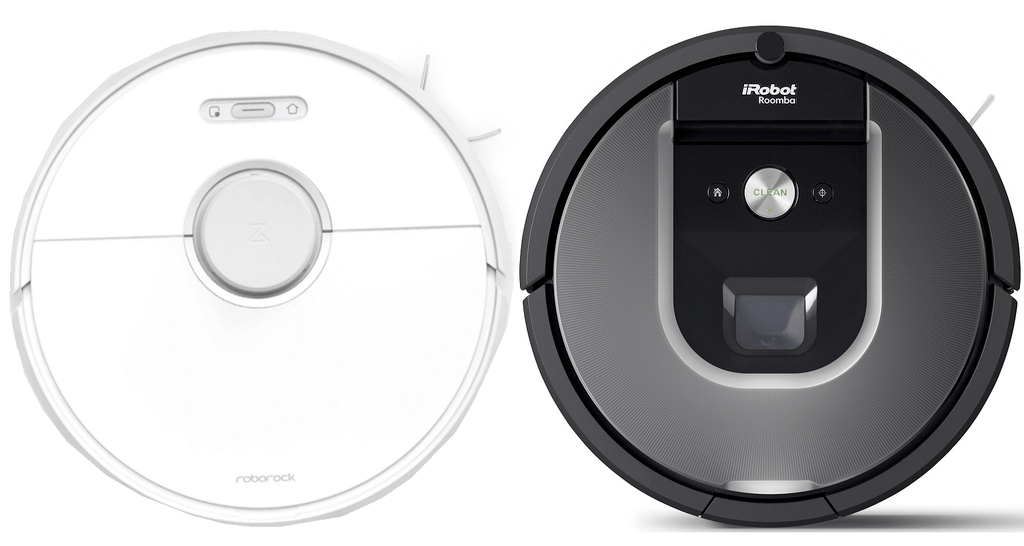In the world of robotics, floor cleaning robots have become more popular than toasters. There is one barrier no robot has been able to cross yet, though. No robot can vacuum, sweep and mop on equal terms. The models that try either fail across the board or only succeed in one of the areas.
The Roomba line has never attempted a moping model. iRobot has dedicated mopping robots for that. Roborock, on the other hand, introduces the S6 model. With high hopes and promises of technological advancements to win over everyone. Will the Roborock S6 be the one to rule them all? Doubtful. Can it compete with the Roomba 960? This article aims to find out. Read on to learn more.
Contents
- 1 Differences between the Roborock S6 vs Roomba 960
- 2 Similarities of the Roborock S6 and Roomba 960
- 3 Specifications Chart
- 4 Comparing the Roomba 960 to Roborock S6
- 5 Frequently Asked Questions
- 5.1 Q. How do I contact Roomba if I have an issue?
- 5.2 Q. Can I contact Roborock customer support?
- 5.3 Q. What types of warranty does Roborock and Roomba offer?
- 5.4 Q. Do I have to have wireless available in my home to use the robots?
- 5.5 Q. How much wood could a woodchuck chuck if a woodchuck could chuck wood?
- 6 What I Like About the Roborock S6
- 7 What I Like About the Roomba 960
- 8 In Conclusion
Differences between the Roborock S6 vs Roomba 960
On paper, there are vast differences in these two models. There are even more when you have them running in your home. Here are the biggest differences that will matter.
[easyazon_image align=”center” height=”500″ identifier=”B07RLRWWPJ” locale=”US” src=”https://smartrobotichome.com/wp-content/uploads/2020/05/515Qbui2NL-1.jpg” tag=”srh-easyazon-20″ width=”500″]- The biggest difference is that the Roborock has the ability to wet mop your floors. Roomba vacuums don’t mop.
- Batteries and Runtimes. The Roborock has a much larger celled battery, providing it with over double the runtime potential compared to the Roomba 960.
- Suction power. Measured in pascals (pa) the S6 has more suction than the 960.
- Real-time location and programming. The Roomba 960 moves around your home following its map. The Roborock can be told which room to go to and when.
- Noise level. Roomba robots aren’t exceptionally loud at 65dB, but the Roborock is much quieter (50dB).
- Stored maps. The Roomba 960 can create, store and use a single layout map. The Roborock S6 can map 3 floors and remember them all.
Similarities of the Roborock S6 and Roomba 960
As floor cleaning robots, the two models are bound to have similarities. Here are the important features they have in common.
- Recharge & Resume. Both models have the ability to automatically recharge their batteries and resume cleaning when the charge is complete.
- HEPA filtration. The two robots use HEAP filtration to help reduce in-home allergens as they clean.
- Mobile app and voice commands. You can control the Roborock S6 and the Roomba 960 with wireless devices.
- Containment options. You can use various containment options to keep the robots where you need them.
- All floor types. The Roomba 960 and Roborock S6 are rated to clean all floor types.
Specifications Chart
Below you will find the side by side comparison of the two robots and all their options and features.
| Roborock S6 | Roomba 960 | |
| Dimensions | 13.7×13.8×3.8 inches | 13.8×13.8×3.6 inches |
| Weight | 7.7 pounds | 8.7 pounds |
| Battery | 5200mAh lithium-ion | 3600mAh lithium-ion |
| Runtime | Up to 250 minutes | Up to 120 minutes |
| Charge Time | 5 hours | 3 hours |
| Automatic Recharge | Yes | Yes |
| Automatic Resume | Yes | Yes |
| Filter | E-11 HEPA, washable | High-efficiency |
| Motor Suction | Up to 2000pa | Up to 1800pa |
| Scheduling | Yes | Yes |
| Spot Cleaning | Yes | Yes |
| Real Time Location and Programming | Yes | No |
| Wireless Communications | Yes | Yes |
| Local Controls | Yes | Yes |
| Mobile App | Yes | Yes |
| Voice Commands | Yes | Yes |
| Navigation | Multi-Sensor Multi-Room | iAdapt 2.0 |
| Mapping | LDS | Camera-based |
| Collection Bin Capacity | 0.5L | 05L |
| Water Reservoir Capacity | 0.15L | N/A |
| Noise Level | 50dB | 65dB |
| Adjustable Water Level | Yes | N/A |
| Select Room Navigation | Yes | No |
| Select Room Scheduling | Yes | No |
| Multiple Maps Stored | Yes (3 maps) | No |
| Containment | Yes (app only) | Yes |
| Side Brush | 1 | 1 |
| Floor Types | All | All |
| Damp Mop | Yes | No |
| Wet Mop | Yes | No |
| Warranty | 2 years | 1 Year |
| Price | Check on Amazon | Check on Amazon |
Comparing the Roomba 960 to Roborock S6
Here is what you want to know: how do these robots actually perform when put on the floors of your home. Here is what you don’t need: a 5-minute video showing you how well these robots can clean inside a tiny box with pre-selected “spills” for them to clean up.
This section breaks down the various features of the robots in real-world settings to show you the real abilities and shortcomings of the Roborock S6 and Roomba 960.
Roborock S6 Vs. Roomba 960 on Hard Flooring
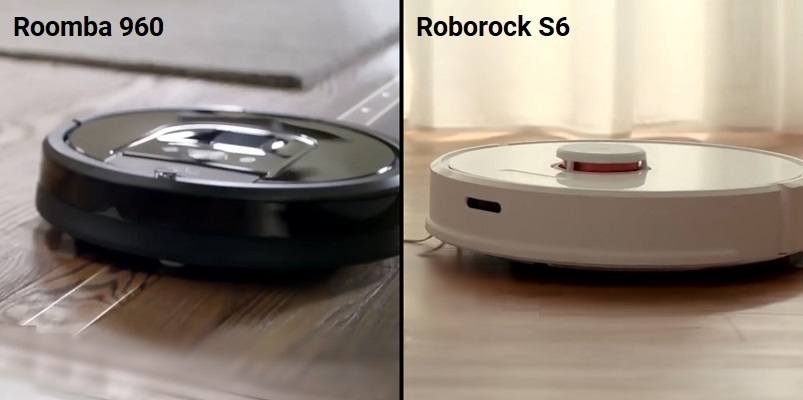
On hard flooring surfaces you would expect that a robot vacuum would rival any other cleaning method, manual or not. In that, you would be wrong. Even on flat hard surfaces like your kitchen floor, robots have limits. Let’s break it down into the various areas and find where the Roborock S6 and the Roomba 960 pass or fail.
In the Middle of the Floor
Before I get too far, I want to let you know that I will not cover mopping in this section. Mopping will have its own topic below . This will focus on the cleaning ability of both robots when sweeping and vacuuming hard flooring only.
The Roborock S6 comes with a lot of suction. At 2000pa (max mode) you can expect that a lot of dirt, dust and debris is collected. For the most part, you’d be correct. In the middle of the floor, the S6 does a good job getting to all areas. With the human-like cleaning patterns and back and forth motions, the robot doesn’t miss much.
The concern here is the brush roller. The bristles on the roller aren’t stiff, but they are soft, either. In an odd hybrid sort of make, the silicone bristles are medium-hard. While this is fine for most flooring, softer surfaces may have small scratches left behind.
The Roomba 960 uses the patented dual rubber paddled rollers. These rollers are bristle free and won’t scratch or mar any surface. Even with a little less suction power, the 960 will clean the middle of your hard floors with ease.
The issue for the Roomba robot is that the side brush spins extremely fast and the exhaust port points towards the floor. This combination has long been a struggle for Roomba models, pushing lighter debris around before cleaning it up. Eventually, everything will be cleaned, but it can look messy during the process.
Along the Edges and Into Corners
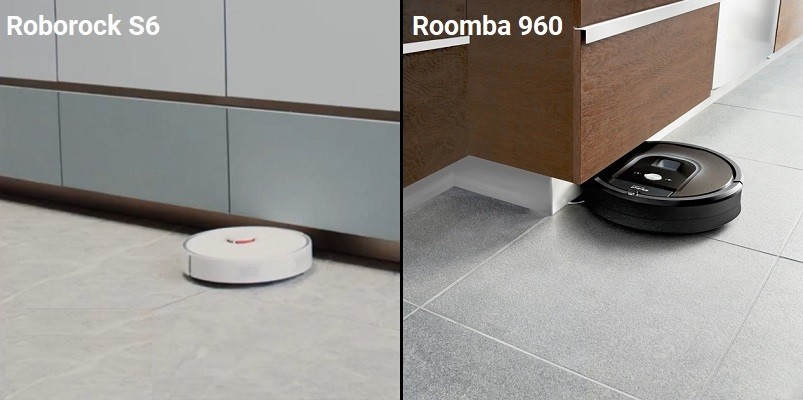
The most difficult cleaning spot for any robot is along the edges and getting into corners. The S6 and 960 are no exception here. Both use a single side brush to gather debris from along the edges. The larger the debris, the easier it is to clean.
Things like pet fur and food crumbs will be collected, though lighter debris and some smaller particles will still be visible along your baseboards after both robots go by.
This doesn’t get much better in the corners, I’m afraid. The two round robots and single side brush will do what they can, but in all honestly it won’t be much. Depending on the amount and type of debris, you will be better off using your broom to sweep the edges and corners to the center of the floor.
Bottom Line: When it comes to hard flooring these two are about equal. The Roomba though, is faster at its job and won’t scratch your floors.
Roborock S6 Vs. Roomba 960 on Carpeting
The true test of any robot vacuum is on carpet (thanks for pointing out the obvious, article writer guy). Unlike lab tests and marketing videos, your floors don’t get measured amounts of perfectly located spills. So how do these two fare when it comes to your carpets? Let’s have a look.
Wall to Wall Carpeting
The Roborock S6 is rated as cleaning all floor types. However, you are going to be disappointed if you have anything other than low-pile carpeting. The single brush roller doesn’t do too well with carpet fibers, pile and loose woven carpets.
On low-pile carpet, though, it does a pretty good job. The agitation is lacking, so the S6 won’t get too deep into the carpet, but the suction is strong enough to remove anything that is loose, regardless of how deep it is.
On the other hand, those brushless rollers on the Roomba 960 come in to play again. The Roomba will actually clean all carpet types, even high-pile. It has a two-speed motor that ramps up power and suction when carpeting is detected. The rollers actually agitate and loosen deep debris.
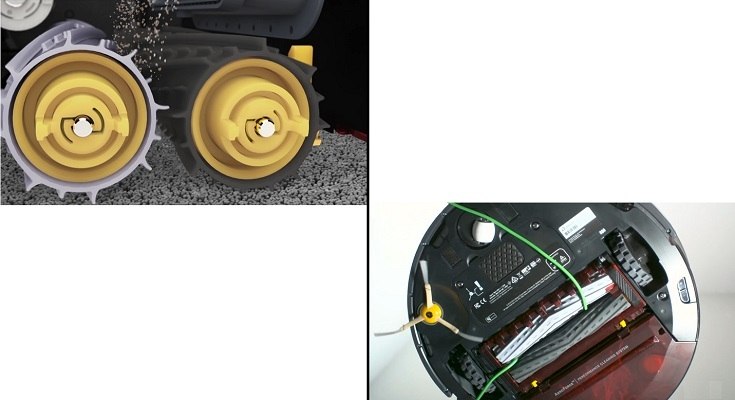
You don’t even have to worry about your power cords, left-behind socks, or other obstacles. If a clog or tangle is detected, the 960 will stop moving and reverse the rollers to free itself. Then, the robot will move around the obstacle so it doesn’t get stuck again.
Throw Rugs and Area Rugs and Fringe
The Roborock S6 will clean throw rugs, area rugs and even those padded carpeting floor covers you have in the bathroom. Smaller and lighter ones, though will be pulled around the house or bunched up in the corner.
Thicker throw rugs may cause issues for the robot if it doesn’t approach just right to get on them. In these cases, the robot will just move around after several failed attempts.
The Roomba 960 does a better job. While lighter throws and smaller area rugs may be bunched up a bit, they don’t get dragged around the house like they sometimes can with the S6.
The one thing you need to watch out for with either model, though, is fringe. If your decorative rugs have fringe, or tassels, you will need to either pick the rug up or tuck the fringe underneath. The S6 has been known to tear fringe or remove tassels and the 960 will suck them up and not be able to unclog itself. It is best to get the fringe out of the equation from the beginning.
Bottom Line: The Roomba 960 wins here. It has a better time cleaning carpet more thoroughly and can take on any carpet type. The Roborock S6 is decent on low-pile carpeting, but not much else.
Only the Roborock S6 Mops
The fact that the Roomba 960 doesn’t have a mopping feature should be a clear sign that the Roborock S6 will win this round. But maybe not.
While a mopping and vacuuming robot is a novel ideal, it has never really worked out, and that doesn’t change here. The S6 does mop. It also provides you with a true wet mop instead of one of those floor buffing microfiber pads that can’t get wet.
There are issues, though (see below) which I will cover. However, for the time being, let’s focus on the positives.
The wet mop is controlled by a 0.15L reservoir. You can select high or low for your water release modes, where low is a slow trickle that lasts longer, but the high mode actually makes your floors wet.
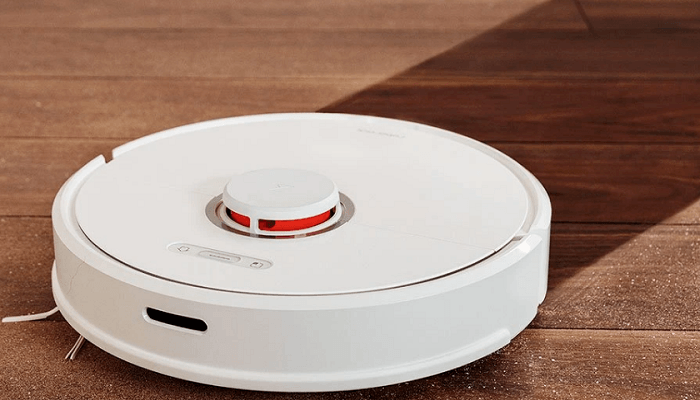
The S6 can also vacuum while it mops, as long as you stop it from hitting the charging station with the reservoir attached. The wet mop on high mode is about the equivalent of a Swiffer Wet without the elbow grease. It will wet the pad and then drag the soaking wet pad behind it picking up some dirt and debris while attempting to be thorough.
Known Issues
Now the bad news. The robot is slow. When you have the mopping attachments installed, it is even slower. Couple that with the fact that Roborock instructs you to run the robot in vacuum only mode three times before you can mop and you have a three to four hour process to accomplish something you can do with a wet rag and your foot in about 10 minutes.
Even following the instructions to the letter, the robot won’t clean very well. Streaks, puddles and water stains are common. To combat this, you will want to use low water mode, but then the floor barely gets wet enough to make any difference at all. The happy medium, doesn’t exist.
Bottom Line: The truth is that the mopping feature is more trouble, hassle and frustrating than it is worth. If I could give the Roomba the win in this category, I would. You may mop with the S6 a few times, but it will soon grow cumbersome and pointless.
Control Options Side with the Roomba 960
When it comes to controlling your robot, you want all of the features in one place. With the Roomba 960 and Roborock S6 this will be in their respective mobile apps. However, there are local controls if you like pressing physical buttons and voice commands if you don’t want to get up.
Local Controls
The local controls are severely limited, and I predict that in the next few model releases we will see local controls completely removed. The S6 has two buttons on top of the robot. One button will send the robot out to clean your floors and the other will stop the cleaning cycle and return the robot to the charging station.
The Roomba has these two buttons as well, but adds a third that will force the robot to perform a spot clean. While no one likes bending over to push buttons, you will find the bulk of the controls in the wireless control methods.
WiFi-Based Controls
If you want to have any form of control, either through voice commands or your phone, you will need to download the mobile apps for either robot. Both are required for set up and initialization, so even if you only want to have voice command options, you still need the app for set up.
With the Roborock model you will get all of the functionality, including scheduling cleaning sessions, canceling a cleaning cycle, forcing the robot back to the charging station and your virtual containment. I will cover this containment in detail below.
For the voice commands, you only get two. Just like the physical controls, Roborock limits your voice commands to either clean or recharge. The Roomba 960 does things a little different.
The Alexa and Google voice commands are quite robust. You can even create, edit and delete schedules. With these commands not only can you start and stop cleaning cycles, but you can also get cleaning reports, statuses and find out where the robot is located.
Still, the majority of the control options will come through the mobile app. Here you can see the map the robot creates, follow along with the cleaning from anywhere and see the battery charge remaining, how long the previous cleaning session lasted and much more.
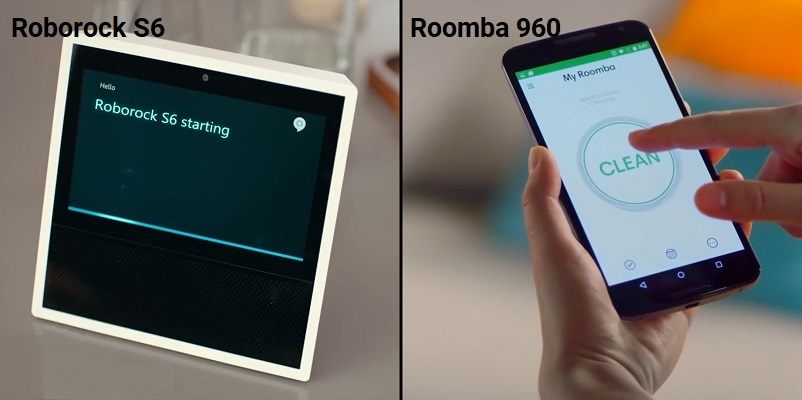
Bottom Line: When it comes to controlling your robot through mobile devices, iRobot and the Roomba line are going to win almost every single time. The 960 offers more choices in all aspects over the S6 so this is an easy win.
Containment Methods for the Roborock S6 and Roomba 960
When it comes to containment options there are two types. You can either use physical barriers like magnetic tape and virtual wall towers, or you can use digital containment through mobile apps. Roborock uses the digital form, while the Roomba 960 uses the barrier type.
All Digital S6
The Roborock S6 doesn’t have any physical containment options. If you are looking for this, you will need to use items you find around your home, like work boots, weighted pool noodles or chairs.
Instead, you can use the map on the mobile app to create no-go zones, draw squares and boxes to contain the robot in (or out of) and define carpeted areas for mopping mode. Note that for mopping you MUST use containment, or else the S6 will find its way to your carpet to mop it.
The no-go lines don’t work very well, to be honest and oftentimes you will find the robot has jumped over the line to clean anyway. Roborock is working on a fix, but so far, it is hit or miss. Some reports say the latest update works great, others are still reporting issues.
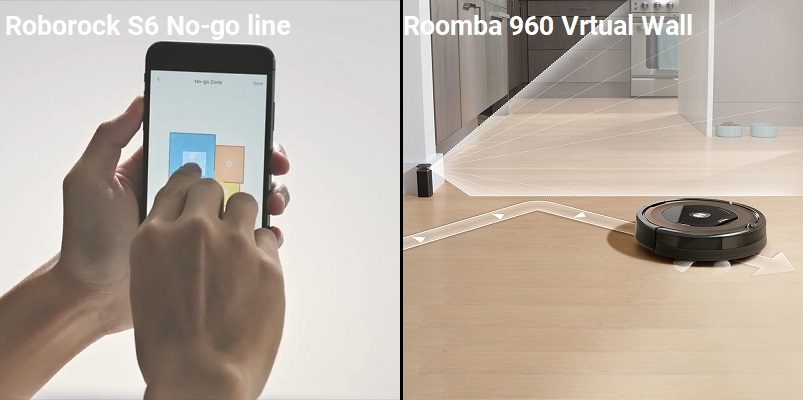
All Barriers 960
The Roomba 960, though, doesn’t have any form of digital containment. iRobot does have Imprint Technology which includes digital containment methods, but those are only found on the Roomba i7 series and Roomba s9 series robots at this time.
Instead you get to use one of the easiest and best containment methods around; the dual-mode virtual wall barriers. These towers have two modes (obvious, again, I know) to produce an infrared beam up to 10-feet in a straight line (linear mode) or a 4-foot diameter circle (halo mode).
You can set these towers up wherever you want to block access, from entry ways, doorways and around pet dishes to separating rooms in half. The Roomba 960 comes with a single barrier, but you can purchase extras at any time. They are sold in single and multi-packs for your convenience.
Bottom Line: Roomba is going to get the slight edge here. While digital containment is wonderful, if it doesn’t work, it can’t win. Until Roborock figures it out, Roomba takes this category.
Frequently Asked Questions
Let me take a moment to answer some of the most commonly asked questions about these two robots. If you have any further questions or concerns, please use the comment section below the article.
Q. How do I contact Roomba if I have an issue?
A. The fastest way is through live chat. You can find the live chat link on the contact page of the iRobot website. There you will also find email addresses for various world-wide regions and departments. You can also call iRobot toll free at 1-800-727-9077.
Q. Can I contact Roborock customer support?
A. You can also contact Roborock. Currently they are still building their website up to be customer-friendly. In the meantime the only contact method is through email. Submit your queries to support@roborock.com.
Q. What types of warranty does Roborock and Roomba offer?
A. The Roborock S6 comes with a 2-year warranty that covers everything from the battery to the motor. However, it does not cover filters, side brushes, brush rollers or mopping pads. The Roomba 960 has the same coverage (minus the mopping pads) but their term is for 12-months.
Q. Do I have to have wireless available in my home to use the robots?
A. You only need wireless networks in your home to use the WiFi features of the robot. Since both models have local controls, you do not need the mobile app or voice commands to use these models.
Q. How much wood could a woodchuck chuck if a woodchuck could chuck wood?
A. It doesn’t really matter if the woodchuck chucks a few chucks or an entire chuck-load. Between the Roborock S6 and the Roomba 960, they would be able to clean it all up.
What I Like About the Roborock S6
- Huge battery with long runtime
- All-in-one model with true wet mop.
- Digital containment (when it works) is the future we need.
What I Like About the Roomba 960
- Reliable, durable and long-lasting performance.
- Doesn’t get stuck on thicker carpeting.
- Best mobile app in the industry that doesn’t fail.
In Conclusion
If you want to save money and have a robot that vacuums, mops and cleans all floor types half-way decent, then the Roborock S6 is a model to consider. It has a lot of advanced features in its arsenal, but none of them seem to stand out in any particular way.
The Roomba 960 is an older robot, so it is missing a lot of the newer technology. However, even by the standards set today it is still a top-tier robot. While it may cost a little more than you would want for a robot of this age, it is dependable, durable and will exceed most of your expectations. For this contest, the edge goes to the Roomba 960, and it is the one I would buy between these two models.
